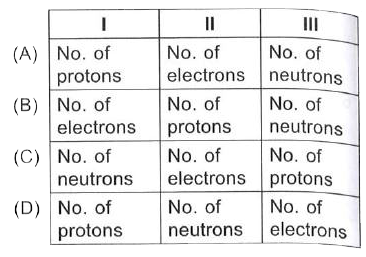Equal number of protons and neutrons in the isotopes make them neutral. 15. Identify the difference between particle of each given pair.
I. 6Liand7Li
II. 32Sand32S2−
III 39K+and40Ca2+.

The correct Answer is:C
6Liand7Li : Same number of protons and electrons but different number of neutrons
32Sand32S2− : Same number of protons and neutrons but different number of electrons.
39K+and40Ca2+ : Same number of electrons and neutrons but different number of protons.
Topper's Solved these Questions
Similar Questions
Identify the number of pairs which have higher electronegativity difference as compared to difference of Cs and F, Na and I, Li and F, H and F, I and CI, Ca dn O, Ba and S, C and Si.
View SolutionWrite the formulae of compounds that would be formed when the following pairs of elements combine.
(i) Mg and N2 (ii) Li and O2 (iii) Ca and H2View Solution
Knowledge Check
- Question 1 - Select One
Calculate number of atoms in each of the following:
I. 0.5 mol of nitrogen
II. 0.2 mole molecules of hydrogen
III. 32 g of sulphurANA/2,2/5NA,NA/2BNA/2,1/5NA,NA/2CNA/3,2/5NA,NA/2DNA,2/5NA,NA - Question 2 - Select One
Directions : In each of the following questions, select the missing number from the given responses.
I. 40 32 72 12
II. 30 24 54 9
III. 54 ? 90 15A46B49C48D36
Find the slopes of the lines passing through the following points :
(i)(1,5) and (3,2)
(ii)(−4,3) and (−6,3)
(iii)(1,3) and (1,4)
(iv)(2,−1) and (3,2)View SolutionPlot the following points and write the name of the figure obtained by joining , them in order p(-3,2), Q(-7,-3), R(6,-3) and S(2,2).
View SolutionWhich of the following is greater between each of the two numbers ?
(i) 330,715 (ii) 225,414 (iii) 221 and 314View SolutionIdentify the reaction order from each of the following rate constants.
(i) k =2.3×10−5Lmol−1s−1
(ii) k =3×10−4s−1View SolutionIdentify the order of a reaction for each of the following rate constants:
i) k=2.3×10−5Lmol−1s−1
ii) k=3×104s−1.View SolutionHow many pairs are, in which first species has lower ionisation enegy than second species:
(i) N and O
(ii) Br and K
(iii) Be and B
(iv) I and I−
(V) Li and Li+
(vi) and O and S
(vii) Ba and Sr.View Solution

